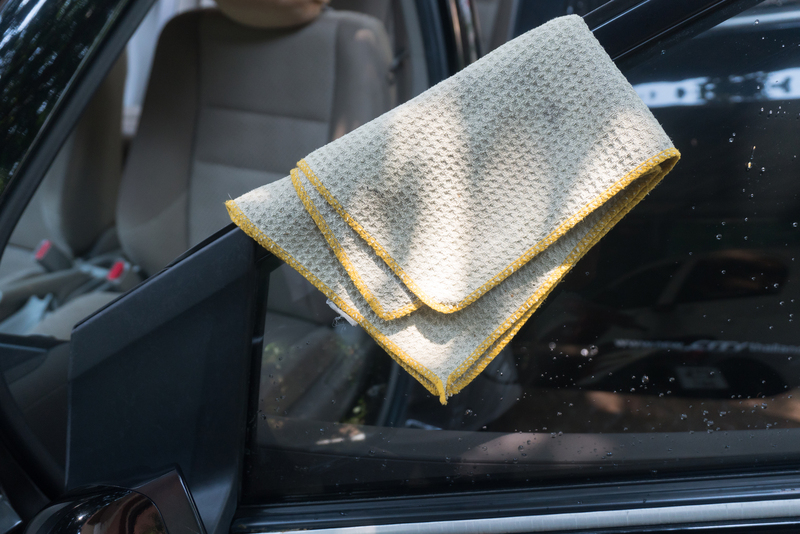Is Steam Cleaning Suitable for Your Leather Sofa?
Posted on 08/06/2025
Is Steam Cleaning Suitable for Your Leather Sofa?
Many homeowners invest in high-quality leather sofas for their unparalleled comfort and timeless aesthetic appeal. But keeping these luxurious pieces clean and well-maintained can be challenging. One modern cleaning option that often sparks debate is steam cleaning. Is steam cleaning suitable for your leather sofa, or should it be avoided? In this comprehensive guide, we explore the pros and cons, expert recommendations, best practices, and alternatives for cleaning your cherished leather furniture.

Understanding Leather Sofas and Their Maintenance Needs
Leather furniture exudes elegance and is prized for its durability and classic look. Nevertheless, it's crucial to understand the unique makeup of leather to care for it properly. Leather is a natural, porous material that can vary in type, finish, and protective coatings. Common types of leather used in sofas include:
- Aniline Leather: High-quality, soft leather dyed with soluble dyes. It has minimal surface coating, making it susceptible to stains and water damage.
- Top-Grain Leather: Slightly processed to remove imperfections, this type is more durable and resistant than aniline leather.
- Full-Grain Leather: The most natural and resilient, retaining the inherent marks and texture, but still vulnerable to moisture.
- Bonded Leather: Made from scraps of leather bonded together - generally less expensive and not as durable.
- Faux Leather (PU Leather): Not genuine leather, but often used in budget-friendly sofas and requires different care.
Each type of leather sofa responds differently to cleaning techniques. Therefore, it's essential to identify your sofa's leather to determine the safest cleaning methods.
The Importance of Regular Leather Sofa Maintenance
Regular maintenance not only keeps your leather sofa looking pristine, but it also extends its lifespan. Over time, leather absorbs oils from our skin, as well as dirt, dust, and spills. If left untreated, these contaminants can cause discoloration, cracks, and permanent stains. Basic maintenance includes:
- Dusting and vacuuming with a soft brush attachment.
- Wiping with a damp, lint-free cloth.
- Using a leather-specific conditioner every few months.
But when deeper cleaning is needed, homeowners may consider advanced options--such as steam cleaning leather couches.
What Is Steam Cleaning?
Steam cleaning is a method that uses high-temperature steam to lift stains, kill bacteria, and remove allergens from various surfaces, including upholstery. High-pressure steam penetrates the surface, dissolving tough grime and sanitizing at the same time, with minimal use of chemicals. This process is particularly effective for fabric sofas and mattresses. But does it have the same positive results for leather upholstery?
How Does Steam Cleaning Work?
A steam cleaner heats water past boiling point to produce pressurized steam. The steam softens dirt, making it easier to wipe away. Commonly, steam cleaners have attachments to help target crevices or delicate areas. Advocates tout the following benefits:
- Deep Cleaning: Reaches into pores and removes stubborn dirt.
- Sanitization: High heat kills dust mites, bacteria, and mold spores.
- Eco-Friendly: Reduces or eliminates the need for chemical cleaners.
Is Steam Cleaning Safe for Leather Sofas?
The suitability of steam cleaning your leather sofa depends on several factors, including leather type, condition, and the method used. Leather is highly sensitive to heat and moisture; when exposed to excessive steam, it can:
- Dry Out: Leather can lose its natural oils, becoming stiff, cracked, or faded.
- Shrink or Warp: Excessive moisture may cause the leather or its underlayers to warp or lose shape.
- Damage Finish: The protective coating can be compromised, resulting in dullness or spots.
Professional upholstery cleaners usually advise caution. While it is possible to use steam on some leather types, the process must be extremely gentle and carefully controlled. For most genuine leather sofas, direct steam cleaning is not recommended.
Manufacturer Guidelines and Steam Cleaning
Before attempting any cleaning technique, always consult your manufacturer's care label. Many brands include cleaning instructions to preserve their products' warranty. If your care tag states "dry clean only" or provides a specific list of approved cleaning products, follow these to the letter. If unsure, contact the retailer or manufacturer directly and ask if steam cleaning is safe for your leather sofa.
Risks of Steam Cleaning Leather Sofas
If not done correctly, steam cleaning can do more harm than good to a leather sofa. Here's why:
- Water Damage: Excess moisture can seep into the sofa's padding and leather fibers, potentially leading to mildew, mold, or structural damage.
- Loss of Natural Oils: Steam removes not only dirt but also the oils that keep leather flexible and lustrous, causing premature cracking or fading.
- Burn or Scorch Marks: Direct contact with hot steam may cause discoloration, warping, or permanent burn marks, particularly on delicate or untreated leather.
- Compromised Adhesives: Many sofas contain glue in seams or foam. Excessive heat or moisture can weaken these adhesives, resulting in loosened edges or fabric separation.
Ultimately, the risks often outweigh the potential benefits, especially with high-value, natural leather couches.
When Is Steam Cleaning Leather Furniture Appropriate?
Though not generally recommended for genuine leather, there are rare cases where a carefully controlled steam process may be used:
- Specialist Intervention: Only professional cleaning technicians with experience in leather care should attempt to steam clean, using specialized, low-moisture equipment.
- Faux Leather or Durable Finishes: Some synthetic leathers or highly protected top-grain leathers may withstand gentle steam, but always test a small, inconspicuous area first.
DIY steam cleaning leather sofas is not advised unless specifically approved by your furniture manufacturer and you have the right tools and skills.
Best Cleaning Practices for Leather Sofas
If you want to clean your leather sofa without risking damage, consider these safe and effective maintenance tips:
1. Routine Dusting and Vacuuming
- Use a dry, soft cloth or microfiber duster to remove surface dust weekly.
- Vacuum in crevices using a soft brush attachment to avoid scratches.
2. Spot Cleaning Spills and Stains
- Blot spills immediately using a clean, dry cloth--never rub!
- For tough spots, use a slightly damp cloth with mild, pH-neutral soap (never harsh chemicals).
3. Conditioning and Protecting Leather
- Apply a leather conditioner every 2-3 months to preserve softness and color.
- Use a leather protectant spray to guard against stains and water damage, especially in high-traffic areas.
4. Professional Cleaning Services
- For deep cleaning, hire a certified upholstery cleaning specialist experienced in leather care.
- Professionals use specialized products and techniques to safely restore your sofa's beauty without risk of steam damage.
Alternatives to Steam Cleaning Your Leather Couch
Instead of steam cleaning, consider these gentle alternatives:
- Leather Cleaning Wipes: Specially formulated for leather surfaces, these wipes effectively remove dirt and mild stains.
- Mild Soap and Water: Diluted soap solution applied sparingly and wiped with a damp (not wet) cloth.
- Vinegar Solution: For light cleaning, mix equal parts distilled white vinegar and water. Use sparingly--test an area first.
- Store-Bought Leather Cleaner: Always choose a cleaner designed specifically for your sofa's leather type. Follow instructions closely.
- Professional Leather Care Kit: Invest in reputable products recommended by furniture brands or leather experts.
DIY Tips: How to Safely Clean Your Leather Sofa at Home
Not sure what products to use? Follow this simple step-by-step routine for general cleaning:
- Remove dust and debris with a soft, dry cloth or vacuum with a soft brush attachment.
- Mix a few drops of mild liquid soap (such as baby shampoo or dish soap) in a bowl of lukewarm water.
- Dampen a microfiber cloth with the solution--never soak it.
- Wipe the sofa gently in sections. Avoid excessive scrubbing or saturating the leather.
- Immediately dry each section with a clean, dry towel.
- Apply leather conditioner and let it absorb before buffing the surface to a shine.
Always test any product or cleaning method on a hidden area first to check for colorfastness or adverse reactions.

Frequently Asked Questions about Leather Sofa Cleaning
Can I steam clean faux leather sofas?
Some faux leather couches may tolerate gentle, low-moisture steam cleaning, but always consult the care label and test in an inconspicuous spot before proceeding. Use the lowest steam setting and avoid prolonged exposure.
What should I never use on my leather sofa?
Avoid any harsh chemicals, ammonia, bleach-based cleaners, or abrasive pads. Do not oversaturate leather with water, and never use regular household cleaners that may strip the finish or cause discoloration.
How often should I professionally clean my leather sofa?
It depends on usage and environment, but most experts recommend professional cleaning every 12-18 months for well-used living room sofas. High-traffic, light-colored, or pet-friendly homes may require more frequent cleanings.
How do I maintain my leather sofa between deep cleans?
Dust regularly, wipe up spills immediately, condition periodically, and keep your sofa away from direct sunlight and heat sources to avoid drying and fading.
Conclusion: Is Steam Cleaning Right for Your Leather Sofa?
While steam cleaning is a powerful option for fabric upholstery and carpeted surfaces, it's generally not recommended for most natural leather sofas. The risks--such as drying, warping, or damaging your sofa's finish--often outweigh the potential benefits. For effective, safe cleaning, follow manufacturer guidelines, use gentle products designed for leather, and invest in regular care. For deep cleans, professional services remain the preferred choice.
If you're unsure about how to care for your particular leather sofa, reach out to the manufacturer or a skilled upholstery cleaner. With the right approach, your sofa will remain a luxurious centerpiece for many years to come!
Still have questions about cleaning your leather couch? Share your concerns or tips in the comments below, and keep your leather looking its best--without the risk!



